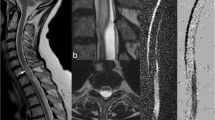Abstract
Imaging of the brain and spinal cord has been transformed by the development of ultrasonography (US), MR imaging, and CT imaging. US is easy to perform at the patient’s bedside, but it is operator dependent. Fully innocuous and clinically very efficient, it still lacks specificity in comparison with other modalities, CT scanning and, mostly, MR imaging. In addition, the use of neuroimaging is restricted in infants whose fontanelles are still open. Because of growing concerns regarding the use of ionizing radiation in children, MRI has become the major imaging modality. Most sequences play a specific role in the diagnosis, and protocols may, on the whole, be tailored to the expected diagnosis in individual patients. It is extremely versatile as, in addition to anatomical images of the nervous system, its envelopes, and its vessels, it can provide information on the structural organization of a lesion, its perfusion, its energy metabolism, as well as its relationship with the “eloquent” neighboring structure and the functions of the surrounding brain. Its main limitation is the need for a sedation in the non-cooperative children. In spite of the risks inherent to the ionizing radiations, CT scanning remains a useful approach in traumatology and in most of the diseases that affect primarily the bone.
Access this chapter
Tax calculation will be finalised at checkout
Purchases are for personal use only
Similar content being viewed by others
References
Abernethy LJ, Avula S, Hughes GM et al (2012) Intra-operative 3-T MRI for paediatric brain tumours: challenges and perspectives. Pediatr Radiol 42:147–157
Chavhan GB, Babyn PS, Thomas B et al (2009) Principles, techniques and applications of T2*-based MR imaging and its special applications. Radiographics 29:1433–1449
Cooper SE, Rabach M, Girardi M (2008) Clinical and histological findings in nephrogenic systemic fibrosis. Eur J Radiol 66:191–199
Dick EA, Patel K, Owens CM, de Bruyn R (2002) Spinal ultrasound in infants. Brit J Radiol 75:384–392
Essig M, Shiroishi MS, Nguyen TB et al (2013) Perfusion MRI: the five most frequently asked technical questions. Am J Roentgenol 200:24–34
Foroglou N, Zamani A, Black P (2009) Intra-operative MRI (iop-MRI) for brain tumour surgery. Brit J Neurosurg 23:14–22
Hayes LL, Jones RA, Palasis S et al (2012) Drop metastases to the pediatric spine revealed with diffusion-weighted MR imaging. Pediatr Radiol 42:1009–1013
Hayes LL, Alazraki A, Wasilewski-Masker K et al (2016) Diffusion-weighted imaging using readout-segmented EPI reveals bony metastases from neuroblastoma. J Pediatr Hematol Oncol 38:e263–e266
ISUOG Education Committee (2007) Sonographic examination of the fetal central nervous system: guidelines for performing the “basic examination” and the “fetal neurosonogram”. Ultrasound Obstet Gynecol 29:109–116
Kanda T, Ishii K, Kawagushi H et al (2014) High signal intensity in the dentate nucleus and globus pallidus on unenhanced T1-weighted MR images: relationship with increasing cumulative dose of gadolinium-based contrast material. Radiology 270:834–841
Kirsch JD, Mathur M, Johnson MH et al (2013) Advances in transcranial Doppler US: imaging ahead. Radiographics 33:E1–E14
Petrella JR, Provenzale JM (2000) MR perfusion imaging of the brain: techniques and applications. Am J Radiol 175:207–219
Raybaud C (2016) Cerebral hemispheric low-grade glial tumors in children: preoperative anatomic assessment with MRI and DTI. Childs Nerv Syst 32:1799–1811
Swinney C, Li A, Bhatti I, Veeravagu A (2016) Optimization of tumor resection with intra-operative magnetic resonance imaging. J Clin Neurosci 34:11–14
Taylor GA, Madsen JR (1996) Neonatal hydrocephalus: hemodynamic response to fontanelle compression – correlation with intracranial pressure and need for shunt placement. Radiology 201:685–689
Valdés Hernández M, Glatz A, Kiker AJ et al (2014) Differentiation of calcified regions and iron deposits in the ageing brain on conventional structural MR images. J Magn Reson Imaging 40:324–333
Author information
Authors and Affiliations
Corresponding author
Editor information
Editors and Affiliations
Section Editor information
Rights and permissions
Copyright information
© 2020 Springer Nature Switzerland AG
About this entry
Cite this entry
Raybaud, C. (2020). Principles of Neuroimaging. In: Di Rocco, C., Pang, D., Rutka, J. (eds) Textbook of Pediatric Neurosurgery. Springer, Cham. https://doi.org/10.1007/978-3-319-72168-2_3
Download citation
DOI: https://doi.org/10.1007/978-3-319-72168-2_3
Published:
Publisher Name: Springer, Cham
Print ISBN: 978-3-319-72167-5
Online ISBN: 978-3-319-72168-2
eBook Packages: MedicineReference Module Medicine




